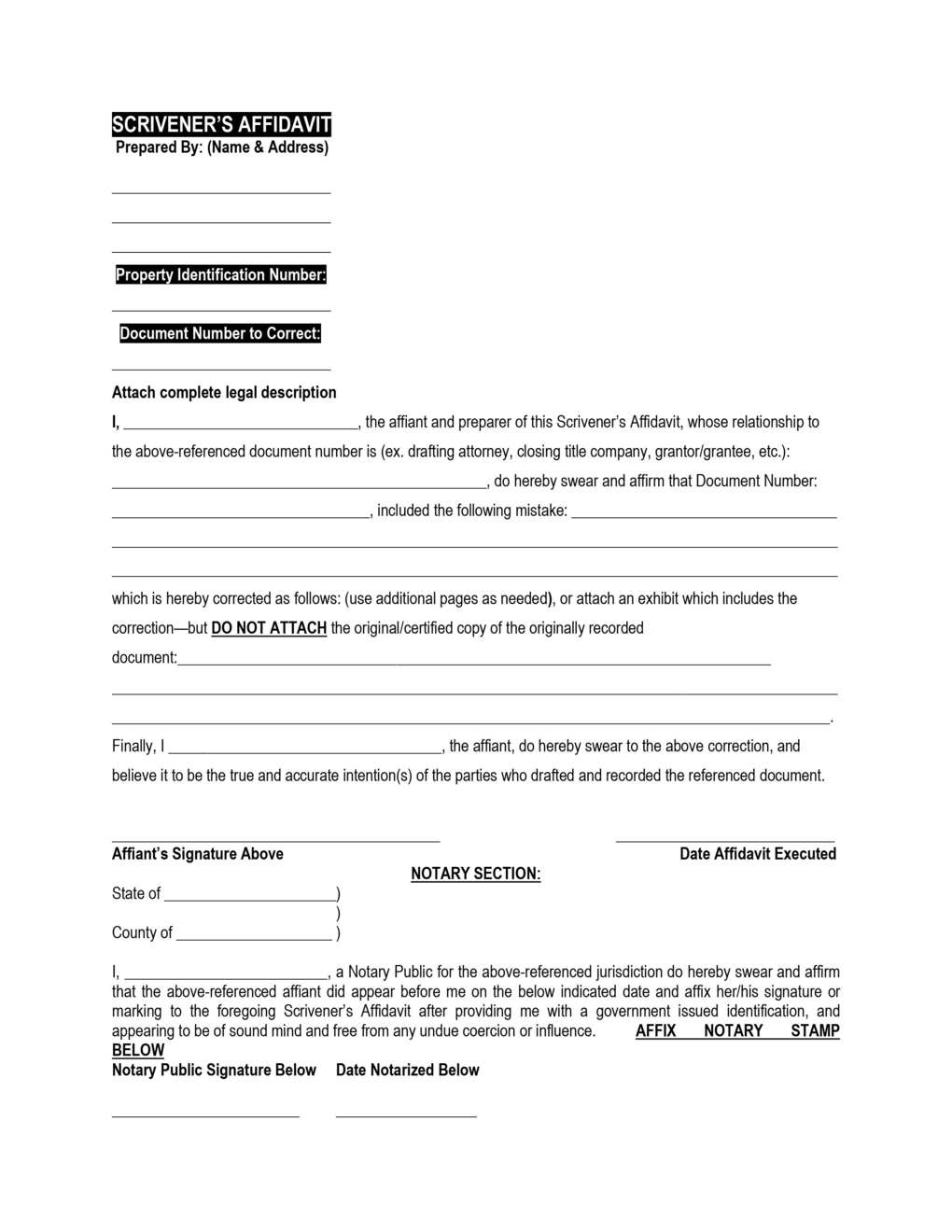A scrivener’s affidavit is a sworn statement of an individual who has executed a legal document and wants to make some changes to it. The fillable affidavit form adds some details or brings minor changes to the legal document.
This affidavit typically comes in the form of a short paper that is aimed at correcting minor errors in existing legal documents. Among such errors might be typographical errors, misspellings of a name, etc. But when it comes to significant changes to the document, a scrivener’s affidavit is not the best way to go. For instance, if parties to a contract write an incorrect term that influences the entire document, they should create an amendment or a new document and execute it.
How Can a Scrivener’s Affidavit Be Used?
As an example, let’s use an imaginary situation. If John Black transfers the title of the real estate to Mary Johnson, and the latter uses a deed to transfer the rights to the property from M. Johnson to Lisa Green, there might be some vagueness in the process of changing the property owners. Real estate title examiners might be not confident in whether Mary Johnson and M. Johnson are the same person. This is when a scrivener’s affidavit comes to help. The document will let Mary Johnson clarify the information in the property records if she states: “M. Johnson and Mary Johnson are the same individual.” In this case, the vagueness in the title will be eliminated.
If a scrivener’s affidavit is used to change a deed, one of the main aspects of using the document is that there should be an original deed that should be present in respective property records. The other thing is that an affidavit should not be used to change the essence of the transaction. In the same way as other affidavits, needs to be sworn under oath and authorized by a notary public in the majority of jurisdictions.
Difference Between a Corrective Deed and Scrivener’s Affidavit
A scrivener’s affidavit might be confused with a corrective deed, but essentially, these are different documents. A corrective deed brings changes to the information already mentioned in the initial deed. A scrivener’s affidavit does not correct existing information; instead, it brings new details to the real estate records with the intention of clarifying certain sections of the document.
In comparison with the same corrective deed, a scrivener’s affidavit has relatively limited use. It should only be used in situations where nothing has to be changed in a deed and title issues can be resolved by adding some information.
What Should a Scrivener’s Affidavit Include?
Even though there is no standardized form of a scrivener’s affidavit, there are certain requisites that should be present in every document of this type:
Who prepared the affidavit
The section is commonly placed in the top left corner of the document and should include the name and address of the affiant. The next thing to include is the property identification number and the document number to correct.

The affiant’s relation to the document, its number, and the type of mistake
In the first paragraph of the main body, the affiant should state how they are related to the document they will bring additions to. For instance, it might be a drafting attorney, closing title company, grantor or grantee, etc. Then you should include the number of the document and specify what mistake you want to correct with the use of the affidavit.
The wording like this might be used: “I, [Name of the affiant], the affiant and preparer of this Scrivener’s Affidavit, whose relationship to the above-referenced document number is [The affiant’s relation to the document], do hereby swear and affirm that Document Number: [The number of the document that is being changed], included the following mistake: [The type of mistake made in the document].

How the mistake is corrected
Next, the affidavit should show in what way the mistake will be corrected. The document might state: ”The mistake is hereby corrected as follows: [Way of fixing the mistake in the document].
If the mistake does not fit in the form, you might use additional pages for specifying the way of fixing the mistake. Please note that you are not supposed to attach the original or certified copy of the document to the affidavit.

Sworn statement
In the last paragraph of the affidavit, you should swear that the information you have included is true and correct.
The following wording might be used: “Finally, I, [Name of the affiant], the affiant, do hereby swear to the above correction, and believe it to be the true and accurate intention(s) of the parties who drafted and recorded the referenced document.”

Affiant’s signature and date of execution
At the bottom of the document, the affiant should include their signature and date of the document.

Notary section
The affidavit form should include the section for the notary acknowledgment where a notary public can affirm the signing of the affidavit by the named affiant. There should be a place for their stamp, signature, and date.

